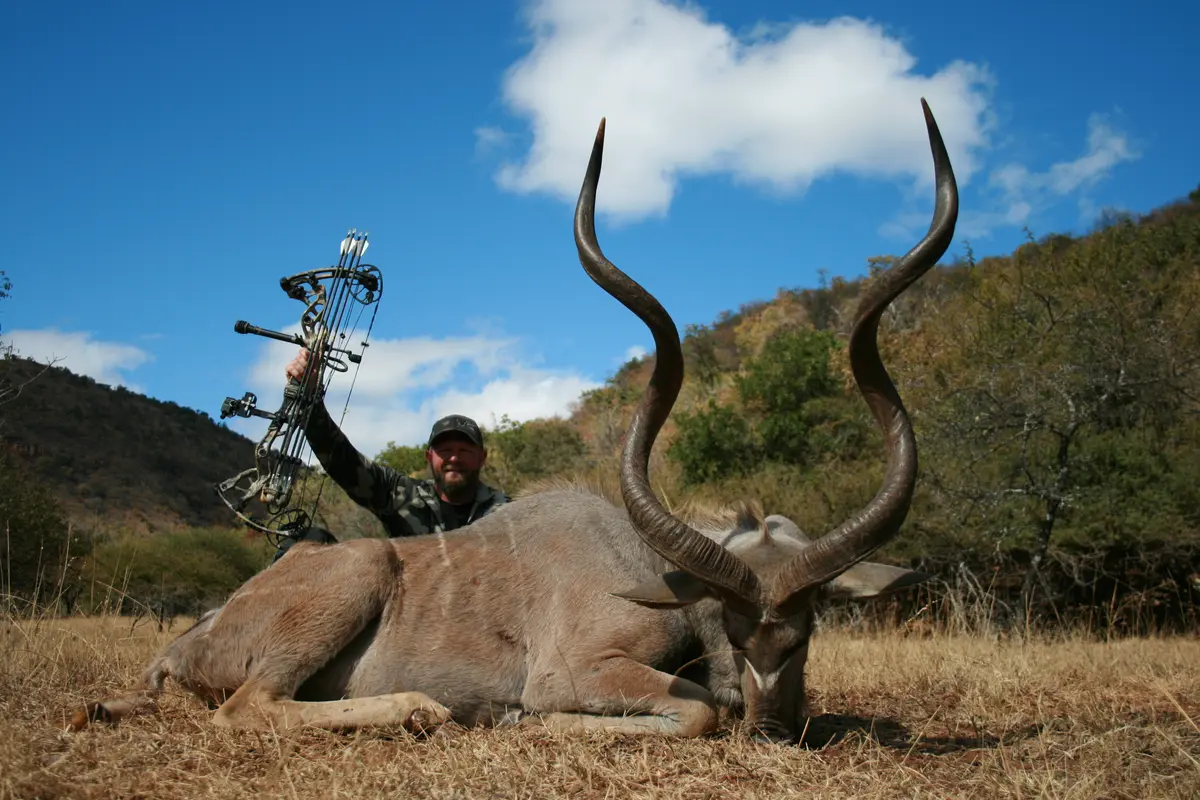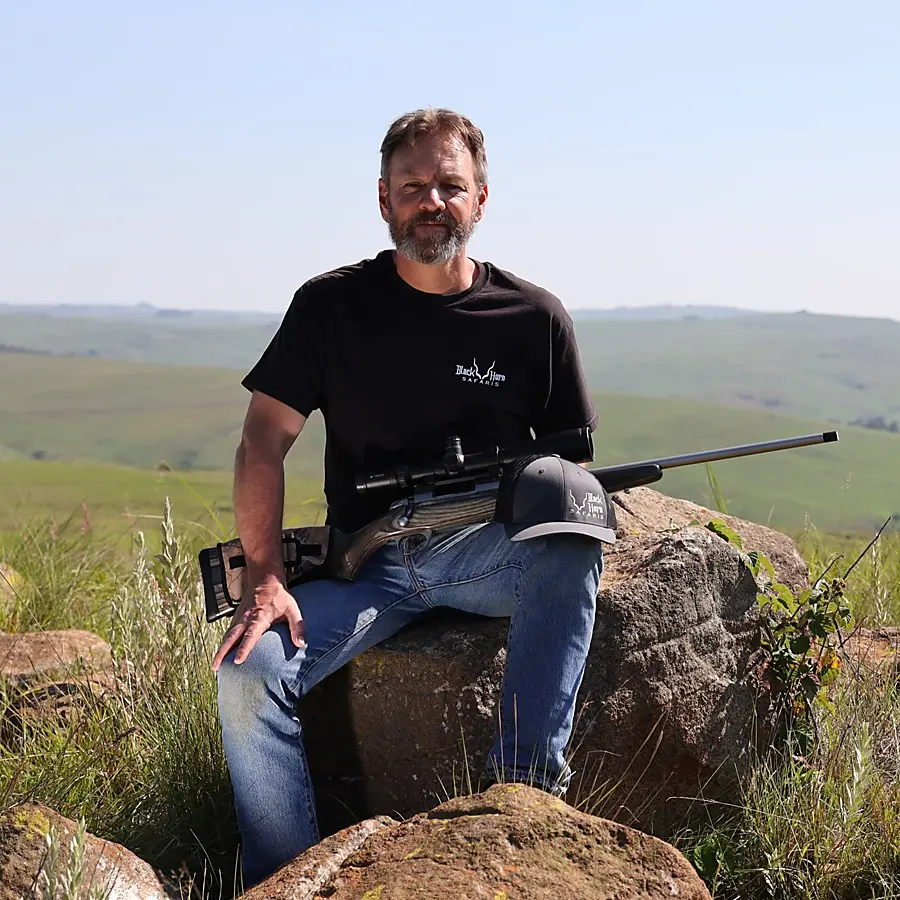
The thrill of bow hunting is all about the challenge and the adrenaline rush that comes with taking down a magnificent animal. And when it comes to big game hunting, nothing quite compares to the experience of bow hunting the majestic Kudu in South Africa. With its iconic spiraled horns and elusive nature, the kudu is a highly prized trophy among hunters, and one of the top species available when you bow hunt in South Africa.
The Kudu: A Remarkable South African Antelope
Before we delve into the art of bow hunting the kudu, let’s take a moment to appreciate this remarkable antelope species. The kudu, scientifically known as Tragelaphus strepsiceros, is native to the mountains and bushveld of South Africa. It is renowned for its distinctive long, spiral horns that can reach an impressive length of up to 74 inches.
The kudu’s large size, elegant appearance, and impressive horns make it a desirable trophy for hunters seeking a challenging and rewarding experience. Their sheer beauty and majestic presence in the wilderness make them one of the most sought-after game species in South Africa and part of the spiral horn slam.
Choosing the Right Bow and Equipment
When embarking on a bow hunting trip for big kudu in South Africa, it is crucial to select the right equipment. Choosing the right bow and accessories can significantly impact your chances of success. Here are some key considerations:
1. Bow Selection
Opt for a compound or crossbow that offers enough draw weight and arrow speed to penetrate through to the kudu’s vital organs. A draw weight of at least 60 pounds is recommended for hunting kudu effectively. Ensure your bow is properly tuned and sighted in to maximize accuracy.
2. Arrows and Broadheads
Select arrows that are specifically designed for big game hunting, preferably made of carbon or aluminum for strength and durability. Consider using expandable broad heads or fixed-blade broad heads with a cutting diameter of at least 1.5 inches for optimal penetration. Your total arrow weight should be 450 grains or more. Try to use fletches or vanes that are as quite as possible to avoid string jumping.
3. Camouflage and Scent Control
Invest in high-quality camouflage clothing that blends well with the surroundings and provides effective concealment. Additionally, use scent control products to minimize human odors, as kudus have an acute sense of smell.
Planning Your Kudu Bow Hunt
A successful kudu bow hunt requires careful planning and preparation. Here are some key factors to consider:
1. Choosing the Right Hunting Area
South Africa offers a diverse range of hunting areas, each with its unique character and challenges. Research various hunting outfitters with good concessions and select an area known for its healthy kudu population. Ensure that the outfitter you choose caters specifically to bow hunters and allows for ethical and fair chase hunting.
2. Timing and Season
Kudu hunting in South Africa is typically available year-round, but the best time for bow hunting kudu is during the dry season, from May to September. During this period, vegetation is sparse, making it easier to spot and track kudus. You will also have greater numbers of kudu coming in to water holes to get a drink, this is important if you will be hunting from a blind.
3. Knowledge of Kudu Behavior
Understanding kudu behavior is crucial for a successful bow hunt. Kudus are known for their keen senses, particularly their exceptional hearing and eyesight. They are also skilled at using their environment and concealment to their advantage. Study their feeding and watering patterns, as well as their preferred habitats, to increase your chances of a successful encounter.
Techniques for Bow Hunting Kudu
Bow hunting kudu requires loads of patience, boundless skill, and intimate knowledge of their behavior. Here are some effective techniques to enhance your chances of success:
1. Spot and Stalk
Spot and stalk is a popular technique for hunting kudu. Begin by glassing open areas, such as grasslands or clearings and hill sides, using binoculars to spot kudus. Once a target is identified, carefully plan your approach, utilizing available cover to get within bow range undetected. Move slowly and quietly, taking advantage of the kudu’s feeding or bedding behavior to close the distance. Always take note of the wind direction and plan your stalk to have the wind blowing in your face at all times.
2. Ambush Hunting
Strategically positioning yourself near well-used game trails, waterholes, or feeding areas can increase your chances of a successful bow hunt. Kudus are creatures of habit and often follow established routes. Setting up an ambush in their frequented areas can provide an opportunity for a well-placed shot. Make sure that you stay concealed and keep your movements to a minimum, kudu have fantastic eye sight and will pick up even the smallest movement
3. Hunting from a Blind
One of the most successful methods of hunting from a well-positioned blind over water or feed. Make sure that the blind is dark inside and that you never get silhouetted against a light background or window. When the kudu comes into range take your time and wait for the kudu to drink or look away before taking the shot.
Shot Placement
Shot placement is a critical factor when hunting Kudu. Achieving a clean and ethical kill requires a hunter to be knowledgeable about the anatomy of the Kudu and to make well-considered decisions based on the animal’s position.
One of the most common and effective shot placements for Kudu is the broadside shot. In this scenario, the Kudu is standing perpendicular to the hunter, presenting a broadside view of its body. The ideal shot placement for a broadside Kudu is behind the front shoulder, just above the midpoint of the body. This shot aims to hit the vital organs, including the heart and lungs. A well-placed broadside shot ensures a quick and humane kill, as it disrupts the animal’s cardiovascular and respiratory systems, causing it to expire swiftly.
Another shot opportunity that may present itself is the quartering away shot. In this situation, the Kudu is positioned at an angle to the hunter, with its hindquarters facing towards the shooter. The quartering away shot involves aiming at the vital organs, typically behind the front shoulder and slightly diagonally towards the opposite shoulder. This shot is effective when executed correctly, as it provides a clear path to the vital organs while minimizing the risk of the arrow hitting bone and causing deflection.
Both the broadside and quartering away shots demand precise marksmanship, careful shot placement, and an understanding of the Kudu’s anatomy. Hunters should always prioritize ethical hunting practices, ensuring that their shots result in a swift and humane harvest while minimizing the animal’s suffering. Additionally, hunters should be aware of their equipment’s capabilities and their own shooting skills to increase the chances of a successful and ethical hunt.
The Ethical and Responsible Hunter
As a bow hunter, it is our responsibility to ensure ethical and responsible hunting practices. Here are a few important guidelines to keep in mind:
– Always prioritize a clean and ethical shot, ensuring a quick and humane kill.
– Practice shooting from various positions and distances to hone your skills and increase your chances of a successful shot.
– Respect the laws and regulations of the hunting area, as well as the guidelines set by professional hunters.
– Appreciate the natural environment and wildlife you are privileged to encounter. Leave no trace behind and preserve the beauty of South Africa’s bushveld.
Conclusion
Bow hunting big kudu in South Africa is an exhilarating adventure that demands skill, patience, and deep respect for the natural world. With the right equipment, careful planning, and an understanding of kudu behavior, you can embark on a challenging and rewarding bow hunting experience. Remember, ethical hunting practices and responsible behavior ensure the preservation of this remarkable species for generations to come. Happy hunting!
FAQ’s Frequently Asked Questions
What makes the kudu a desirable trophy for bow hunters in South Africa?
The kudu is a highly prized trophy among bow hunters in South Africa due to its large size, elegant appearance, and impressive spiral horns. Its beauty and majestic presence in the veld make it a sought-after game species.
What should I consider when choosing a bow for hunting kudu?
When selecting a bow for hunting kudu, it is recommended to choose a compound bow with a draw weight of at least 60 pounds. It should be properly tuned and sighted in for maximum accuracy.
What type of arrows and broad heads should I use for hunting kudu?
For hunting kudu, it is advisable to use arrows specifically designed for big game hunting, preferably made of carbon fiber for strength and durability. Consider using expandable or fixed-blade broad heads with a cutting diameter of at least 1.5 inches weighing 125 – 150 grains, total arrow weight should be 450 grains or more for optimal penetration.
What should I consider when planning a kudu bow hunt in South Africa?
When planning a kudu bow hunt in South Africa, it is important to choose the right hunting outfitter that suits your preferences and offers good trophy animals. Research various hunting areas and consider factors such as terrain, vegetation, and game animal populations.

Adrian Anderson first obtained his Professional Hunters license in 1991. He is a Big Five and Dangerous Game licensed Professional Hunter and Hunting Outfitter. He has a tremendous love for wildlife and the African bush and enjoys sharing his knowledge with the hunting clients that he guides. Guiding hunters in Africa’s wild places is a passion and seeing them succeed with their goals brings satisfaction. With knowledge of the Safari industry built up over 32 years he is well qualified to give guidance to his hunting clients.
